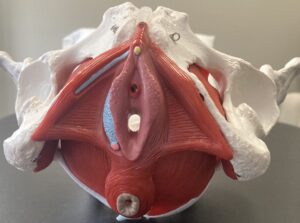As a pelvic health physical therapist, my role is to assess and treat the physical aspects of vaginismus. My goal is to help you regain control over your pelvic floor muscles, reduce pain, and build confidence in your body. Here are some of the ways pelvic floor physical therapy can help:
1. Pelvic Floor Assessment
The first step in physical therapy for vaginismus is a thorough evaluation of your pelvic floor muscles. This may involve both an external and, when appropriate, an internal exam to assess muscle tone, strength, flexibility, and any trigger points or areas of tension. One tool I often use is Q-tip testing— By using a soft Q-tip, I check to see if there are sensitive areas in the vulva. This helps me differentially diagnose what is could be causing the pain with insertion. Is the vulvar tissue healthy or are they just tight?
2. Pelvic Floor Relaxation Techniques
The foundation of treating vaginismus is teaching the pelvic floor muscles to relax. I guide patients through various relaxation techniques, such as:
Diaphragmatic Breathing: This type of deep breathing helps activate the diaphragm and relax the pelvic floor muscles.
Progressive Muscle Relaxation (PMR): PMR involves tightening and then slowly releasing different muscle groups throughout the body to help reduce overall tension.
Mindfulness and Visualization: These techniques can help reduce the anxiety and fear associated with penetration, allowing the body to gradually release tension.
3. Manual Therapy
Manual therapy involves hands-on techniques to address muscle tightness and restriction. For vaginismus, this can include both external pelvic floor massage and, when appropriate and comfortable, internal pelvic floor release techniques. These methods are aimed at relaxing the muscles and improving their function.
4. Vaginal Dilator Therapy
One of the most effective treatments for vaginismus is dilator therapy. This involves the gradual use of small, medical-grade vaginal dilators to help desensitize the vaginal muscles and reduce the reflexive muscle contractions that occur during attempted penetration. The process starts with the smallest dilator, and over time, you’ll work up to larger sizes as comfort and confidence build. This method is done at your own pace, and I guide you through the process to ensure it’s both comfortable and effective.
5. Education and Body Awareness
In physical therapy, education is key. I work with patients to help them understand their pelvic floor anatomy, muscle function, and the connection between the mind and body. This empowers you to be more in tune with your body and gain confidence in managing muscle tension and pain.
6. Collaboration with Other Professionals
Vaginismus is not just a physical condition—it can also have psychological and emotional components. I often collaborate with sex therapists, counselors, or psychologists to address these aspects, providing a comprehensive, multidisciplinary approach to treatment.

